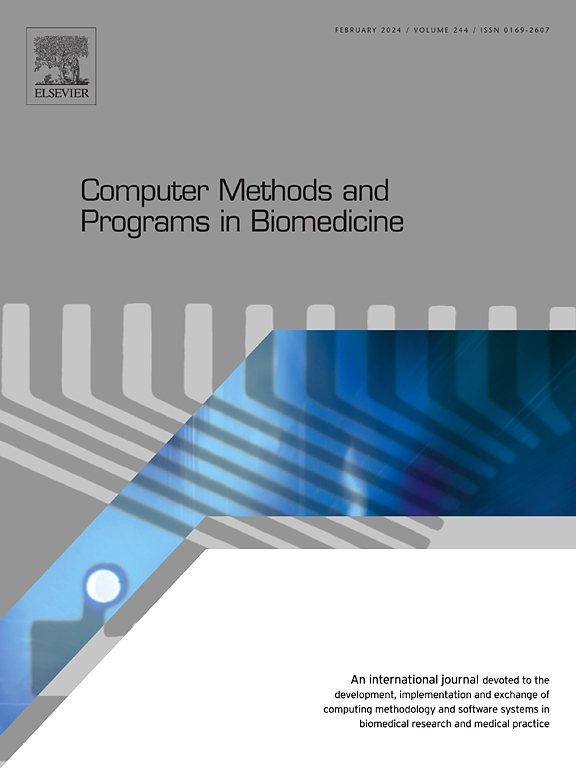基于外观残差的多模态脑磁共振图像对称形变配准。
IF 4.9
2区 医学
Q1 COMPUTER SCIENCE, INTERDISCIPLINARY APPLICATIONS
引用次数: 0
摘要
背景和目的:多模态脑磁共振图像的形变配准面临着重大挑战,主要是由于受试者之间存在实质性的结构差异,以及不同成像模式下外观的显著差异。方法:本文提出基于一种模态到另一种模态的外观残差对两种模态的图像进行对称配准。通过模态之间的简单相减计算,外观残差增强了结构细节,形成了简化多模态形变配准的通用表示。该框架由三个连续连接的模块组成:(i)外观残差模块,该模块学习具有周期一致损失的模态之间的强度残差映射;(ii)可变形的配准模块,该模块基于外观残差预测受试者之间的变形;(iii)去模糊模块,增强扭曲图像以匹配原始图像的清晰度。结果:在两个公共数据集(HCP和LEMON)上对所提出的方法进行了评估,与最先进的方法相比,该方法在拓扑保留的情况下达到了最高的配准精度。结论:残差空间引导配准框架与基于gan的图像增强相结合,为多模态形变配准提供了有效的解决方案。通过减轻强度分布差异和改善图像质量,该方法提高了配准精度,增强了其临床应用潜力。本文章由计算机程序翻译,如有差异,请以英文原文为准。
Symmetric deformable registration of multimodal brain magnetic resonance images via appearance residuals
Background and Objective:
Deformable registration of multimodal brain magnetic resonance images presents significant challenges, primarily due to substantial structural variations between subjects and pronounced differences in appearance across imaging modalities.
Methods:
Here, we propose to symmetrically register images from two modalities based on appearance residuals from one modality to another. Computed with simple subtraction between modalities, the appearance residuals enhance structural details and form a common representation for simplifying multimodal deformable registration. The proposed framework consists of three serially connected modules: (i) an appearance residual module, which learns intensity residual maps between modalities with a cycle-consistent loss; (ii) a deformable registration module, which predicts deformations across subjects based on appearance residuals; and (iii) a deblurring module, which enhances the warped images to match the sharpness of the original images.
Results:
The proposed method, evaluated on two public datasets (HCP and LEMON), achieves the highest registration accuracy with topology preservation when compared with state-of-the-art methods.
Conclusions:
Our residual space-guided registration framework, combined with GAN-based image enhancement, provides an effective solution to the challenges of multimodal deformable registration. By mitigating intensity distribution discrepancies and improving image quality, this approach improves registration accuracy and strengthens its potential for clinical application.
求助全文
通过发布文献求助,成功后即可免费获取论文全文。
去求助
来源期刊

Computer methods and programs in biomedicine
工程技术-工程:生物医学
CiteScore
12.30
自引率
6.60%
发文量
601
审稿时长
135 days
期刊介绍:
To encourage the development of formal computing methods, and their application in biomedical research and medical practice, by illustration of fundamental principles in biomedical informatics research; to stimulate basic research into application software design; to report the state of research of biomedical information processing projects; to report new computer methodologies applied in biomedical areas; the eventual distribution of demonstrable software to avoid duplication of effort; to provide a forum for discussion and improvement of existing software; to optimize contact between national organizations and regional user groups by promoting an international exchange of information on formal methods, standards and software in biomedicine.
Computer Methods and Programs in Biomedicine covers computing methodology and software systems derived from computing science for implementation in all aspects of biomedical research and medical practice. It is designed to serve: biochemists; biologists; geneticists; immunologists; neuroscientists; pharmacologists; toxicologists; clinicians; epidemiologists; psychiatrists; psychologists; cardiologists; chemists; (radio)physicists; computer scientists; programmers and systems analysts; biomedical, clinical, electrical and other engineers; teachers of medical informatics and users of educational software.
 求助内容:
求助内容: 应助结果提醒方式:
应助结果提醒方式:


